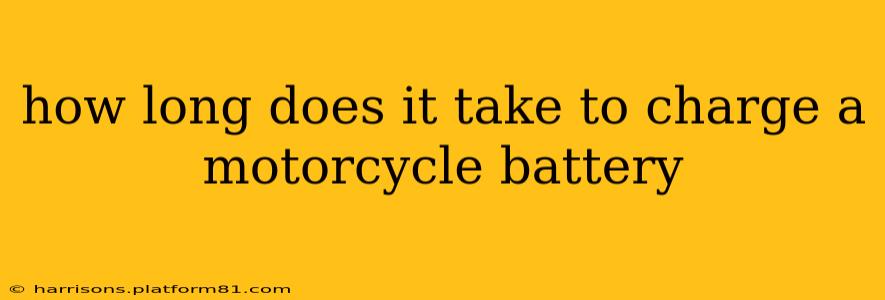Charging a motorcycle battery's duration depends on several factors, making it impossible to give a single definitive answer. However, understanding these factors will help you accurately estimate the charging time for your specific situation. This guide will break down the variables influencing charging time and offer guidance on optimizing the process.
What Factors Affect Motorcycle Battery Charging Time?
Several key factors influence how long it takes to fully charge your motorcycle battery:
-
Battery Capacity (Ah): The Amp-hour (Ah) rating indicates the battery's capacity. A higher Ah rating means a larger capacity and, consequently, a longer charging time. A 10Ah battery will generally charge faster than a 20Ah battery.
-
Charger Output (Amperes): The charger's amperage output dictates the rate of charge. Higher amperage chargers deliver more power, resulting in faster charging times, but using too high an amperage can damage the battery. Always refer to your battery's manufacturer's recommendations for the maximum charging amperage.
-
Battery's State of Discharge (SoD): A completely discharged battery will naturally take longer to charge than one that's only partially depleted. A battery at 50% SoD will charge much faster than one at 0%.
-
Battery Age and Condition: Older batteries, or those in poor condition due to sulfation or other issues, may charge more slowly and may not achieve a full charge.
-
Ambient Temperature: Extreme temperatures, both hot and cold, can negatively impact charging efficiency and prolong charging times. Ideal charging temperatures are generally between 60-80°F (15-27°C).
-
Charger Type: Different chargers utilize various charging methods (e.g., constant current, constant voltage). Smart chargers are generally more efficient and safer, optimizing the charging process and potentially reducing charging time.
How Long Does it Typically Take?
While there's no single answer, here's a general guideline:
-
Using a slow charger (under 1 Amp): Expect 8-12 hours for a moderately discharged battery.
-
Using a standard charger (1-3 Amps): Charging time might range from 4-8 hours.
-
Using a fast charger (3+ Amps): Charging could take as little as 2-4 hours, but always consult your battery's specifications and the charger's instructions to ensure you're within the safe amperage range. Overcharging can severely damage your battery.
Important Note: These are estimates. Always refer to your specific battery's and charger's instructions for the most accurate charging times and recommended amperage.
Can I Overcharge a Motorcycle Battery?
Yes, overcharging can significantly harm your motorcycle battery. Overcharging leads to excessive heat buildup, potentially causing damage to the internal plates and shortening the battery's lifespan. In severe cases, overcharging can even lead to explosions or battery failure. Always use a charger designed for motorcycle batteries and follow the manufacturer's instructions carefully.
What are the signs of a bad motorcycle battery?
A bad motorcycle battery may exhibit several symptoms, including:
- Slow cranking: The engine turns over slowly or struggles to start.
- Dim headlights: Headlights may be dimmer than usual.
- Electrical problems: Other electrical components may malfunction.
- Battery swelling or leaking: This indicates significant damage and requires immediate attention.
If you experience any of these, it's advisable to have your battery checked by a professional.
How can I prolong the life of my motorcycle battery?
Proper maintenance significantly extends the lifespan of your motorcycle battery. Here are some key tips:
- Regular charging: Keep the battery adequately charged, especially during periods of inactivity.
- Clean battery terminals: Corrosion on terminals can impede performance. Clean them regularly with a wire brush and baking soda solution.
- Store properly: If storing the battery for extended periods, charge it fully and store it in a cool, dry place.
- Avoid deep discharges: Deep discharges significantly shorten battery life.
By following these guidelines and paying attention to your battery's condition, you can maximize its lifespan and avoid unexpected charging challenges. Remember to always consult your battery and charger manuals for specific instructions.
